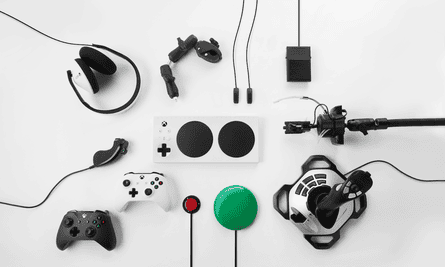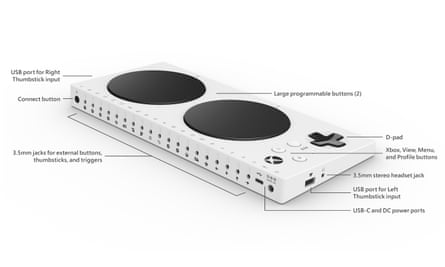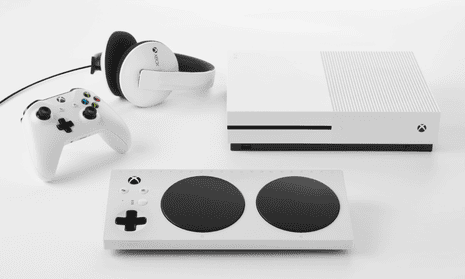Microsoft is launching a new Xbox controller, developed to meet the needs of people with disabilities.
Set for release later this year, the Xbox adaptive controller is a customisable device intended to support a wide range of needs and disabilities, making video games more accessible. It will retail for $99 (£73.50) and will be sold worldwide via Microsoft digital stores.
“We think the traditional Xbox controller is an industry-leading design, but it’s not accessible to gamers with limited mobility,” said Gabi Michel, the senior Xbox hardware programme manager. “They usually require custom solutions which can cost thousands of dollars and a lot of technical expertise to set up; you often have to go to a non-profit organisation to get them made and there are waiting lists. We wanted to solve all those problems; we created the Xbox adaptive controller to be accessible and affordable.”
The controller features two large buttons on the face, which can be operated with hands, elbows or feet. It is designed to be placed on the player’s lap, on a table, or on the floor, allowing for a number of control options.
The main feature is the row of 3.5mm ports along the rear of the pad, representing each of the inputs and buttons on the standard controller. Using these 19 ports, players can plug in a range of add-on devices such as bite switches, foot pedals, touch-sensitive pads and other accessibility products that are either already available or have been developed specifically for the controller by third-party manufacturers. These will also be on sale via Microsoft stores. In this way, control setups can be highly personalised: players use a dedicated app to create controller configurations, and can quickly switch between three preconfigured profiles using a button on the face of the controller.

The device is wireless and powered by an internal battery, charged via USB-C connection. However, it also comes with its own optional power supply so that devices that draw a lot of power – such as mouth-operated quadsticks, controllers designed for quadriplegic players that use a “sip and puff” tube for inputs – can be supported more easily. There is a headphone socket and, on the base, a set of mounting ports, allowing players to fix the controller to a tripod.
During a demo event at Microsoft’s campus in Redmond, Washington, learning specialist Solomon Romney showed how he could control the racing simulation Forza Motorsport with one hand, utilising a specially designed joystick add-on developed by peripherals firm PDP, resembling a Nintendo Wii nunchuck. Plugging the nunchuck, which will retail at $20, into the Xbox adaptive controller’s left USB port, he used the analogue stick and two buttons to steer, brake and accelerate.
According to Microsoft, the adaptive controller, which is also compatible with Windows 10 PCs, is completely plug and play – users are able to repeatedly swap out add-on components while playing.
“As I’m going through various games, I’m trying different configurations, testing how it feels without ever having to quit out and start again,” said Romney. “It makes it much easier to iterate and find the ideal setup very quickly. I can now play whatever game I want, however I want to play it.”

The device originated with a small group of staff from the company’s accessibility team, who developed an early prototype for a Microsoft hackathon event in 2015. They worked closely with Warfighter Engaged, a charity seeking to rehabilitate injured military veterans, to design a customisable controller that met a range of needs but still had the build quality and look of a traditional controller.
The following year, the team was back at the hackathon, this time with the support of Leo Del Castillo, Microsoft’s general manager of Xbox hardware, who committed a group of electrical and mechanical engineers to the project to help improve the design. A year – and several prototypes – later it was officially greenlit.
“The traditional Xbox controller makes a lot of assumptions,” said Bryce Johnson, Microsoft’s senior inclusive designer, who was part of the original development team. “It assumes I have two hands to hold it, two thumbs to hit the analogue sticks, and the fine motor control to get at all the buttons. It also assumes I have the endurance to hold it for a long gaming session. That’s a barrier. Throughout the design process of this device, we spoke to charities like the Cerebral Palsy Foundation, AbleGamers and SpecialEffect and to countless gamers with disabilities. We’ve designed a device that we think will empower them.”
The design team has also worked with occupational therapists including Erin Muston-Firsch, an assistive technology specialist at Craig hospital, Denver, which treats people who’ve had spinal cord or traumatic brain injuries. Muston-Firsch and her patients tested and fed back on prototypes as they were developed. “I have a patient named Reece. She has 15 brothers and sisters, and she used to teach her younger siblings how to play – it was the way they related to each other,” said Muston-Firsch.

“Then she had a spinal injury, a major trauma, and she couldn’t do that anymore. She came to me for rehab and I sat her up with the Xbox adaptive controller and within five minutes she was playing Call of Duty, co-piloting with her brother – he was controlling the right analogue stick but she was doing everything else. It was awesome. Her mother was crying because it was such a powerful moment.”
The prices of add-ons for the adaptive controller range from $65 for an AbleNet Big Red Switch to $399 for a QuadStick. It’s likely some users will require several to build a workable control setup. However, the device also supports the Xbox One co-pilot feature, which allows two controllers to be used as one input. Consequently, many players will be able to create a useable setup with just the adaptive controller and a traditional pad.
Evelyn Thomas, Microsoft’s accessibility programme manager for Xbox, said the new controller is a major hardware launch, and the company will support it with further updates in the future. “There are millions of gamers out there with a wide variety of disabilities. That’s why we feel this device is so important,” said Thomas. “This is not a niche product.”

Comments (…)
Sign in or create your Guardian account to join the discussion